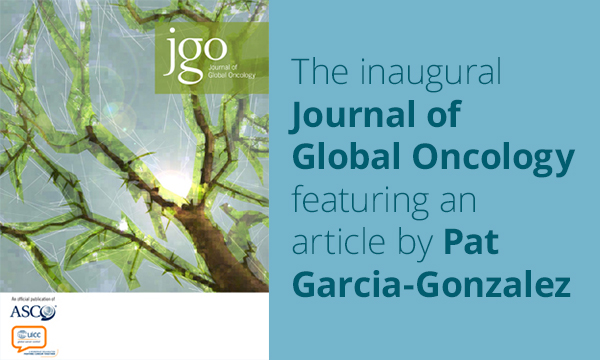
Last week ASCO launched the inaugural issue of the Journal of Global Oncology. This new open access, online journal focuses exclusively on cancer research, treatment, and the delivery of care in middle and low resource countries.
Among the first seven articles, published on September 23rd, are original research, commentaries, and review articles, including a special article looking at the Glivec International Patient Assistance Program, authored by our CEO Pat Garcia-Gonzalez, MS, and others.
We asked Pat a few questions about the article to get a behind-the-scenes glimpse into the mission and purpose of our treatment access program. Read on to hear her thoughts.
Josué: How did the publication come about?
Pat: I was encouraged by one of the members of our Advisory Board to develop the manuscript, given the role that The Max Foundation’s partnership with Novartis around access to imatinib through the Glivec® International Patient Assistance Program has played in changing the paradigm around access to innovative oncology treatment in low-and-middle-income countries. I felt it was very important to produce the manuscript in partnership with those who have been involved in this program from the beginning, thus the choice of my co-authors.
The paper describes in great detail the GIPAP program, and, most importantly, The Max Foundation’s model of patient support and tracking, which is key to the success of the program. A company may make their drugs accessible to patients, but if patients are not able to navigate the program – if there are no support services for patients and for treating physicians – few would actually be able to access the drug. This is especially important for treatment regimens like Glivec where patients must stay on the therapy indefinitely.
Josué: Why was it important for you to tell the GIPAP story?
Pat: The GIPAP program – its model, scope, and impact – are extraordinary in many ways. GIPAP has been and continues to be the most far-reaching humanitarian drug access program for an oncology product in history. The GIPAP model provides a new paradigm in access to treatment programs and is a model now broadly adapted to access programs for any targeted therapy. As program administrators, we track the treatment of each patient, one at a time, in partnership with his or her treating physician. We have operated in 80 countries, approving the delivery of more than 3 million monthly doses of the drug and working for 14 consecutive years in partnership with 1,500 hematologists and oncologists, as well as the program sponsor.
The early launch of the GIPAP is also extraordinary; the program was launched almost simultaneously with the approval of the drug by the US Food and Drug Administration (FDA) and the European Medicines Agency (EMA), so patients in low-and-middle-income countries had access to this innovative drug at the same time as patients in the Western world. This approach was quite unprecedented and has gone a long way towards building a more equitable world.
Josué: What is the main thing you want people to take away from this publication?
Pat: The first message I want people to understand is that it is actually possible to safely treat patients with a targeted therapy in all regions of the world. Additionally, that it is also possible for an international non-governmental organization (INGO) to partner with a pharmaceutical company for the benefit of patients. And finally, that with the right model, it is possible to maintain patients with chronic conditions on therapy for many years, avoiding drug diversion and other challenges that have plagued the world of international humanitarian drug donations.
Please don’t get me wrong; I am not saying it is easy. At this moment in time, for instance, we are caring for 33,000 patients on treatment, one at a time. You have seen the extraordinary dedication of our team, and I can assure you it takes an equally dedicated team at Novartis, and the most hardworking and dedicated treating physicians, some of whom today actively oversee the treatment of more than 1,000 patients. But it is possible with the right commitment and with the right goals in mind.
I also want people to know that access to treatment can be a catalyst for strengthening the healthcare system. GIPAP has been pivotal in the introduction of diagnostics, training of more healthcare providers, development of systems, and inspiring the formation of patient associations. I have observed that in the field of global health, stakeholders are often ready to provide resources to strengthen the healthcare system, provide training, and so on, but reluctant to provide access to the drug, giving as an excuse issues such as lack of diagnostics. Well, there is no better incentive to strengthen systems than the availability of the treatment. I want people to understand this key point.
The last point I would mention is that a drug access program requires a long-term vision; it needs to be understood as an investment in a community and a partnership with each patient. The Max Foundation is poised to work hand in hand with those who are prepared to step-up and make the investment, and I can promise you that everyone, and especially the patients, will step-up with them.
Josué: Thanks for sharing the background on the publication, Pat. The article serves to showcase the many lessons learned from GIPAP and the broad applicability for future treatment access solutions. Read Pat’s article here and find other articles featuring global oncology on the ASCO Journal of Global Oncology site.

